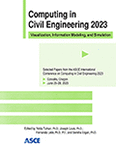A Fuzzy Model and Decision-Support Tool for Assessing and Predicting the Probability of Bankruptcy of Construction Companies
Publication: Computing in Civil Engineering 2023
ABSTRACT
Construction firms face considerable risks that might lead to business bankruptcy. Failed construction companies leave behind unfinished projects, which leads to huge losses to project owners. While previous studies were conducted to understand the factors that contribute to the bankruptcy of construction organizations, little to no research was performed to quantitatively assess the risk of construction business bankruptcy. Hence, this paper addresses this knowledge gap by developing a fuzzy model for predicting the probability of business bankruptcy of construction companies. First, the following six failure warning signs were considered: financial management system, borrowed credit, estimating and job-cost reporting, project management, business plan, and communication. Second, 22 business-related attributes were identified and included in the proposed decision-support tool. Third, fuzzy membership functions and linguistic rules were developed based on expert consultation. Fourth, the Mamdani method was utilized for the inference and composition of the fuzzy linguistic terms. Finally, demonstrative case studies were presented to show the use of the developed fuzzy model and decision support tool. The results compared the risk of business bankruptcy for different scenarios as well as investigated the impacts of different combinations of business warning signs on the probability of bankruptcy. The findings also highlighted the importance of having early warning mechanisms for business management in the construction industry. This paper adds to the body of knowledge by developing a predictive model that helps construction companies forecast the risk of bankruptcy and take the needed corrective actions to avoid business bankruptcy.
Get full access to this article
View all available purchase options and get full access to this chapter.
REFERENCES
Abdelgawad, M., and Fayek, A. R. (2010). Risk management in the construction industry using combined fuzzy FMEA and fuzzy AHP. Journal of Construction Engineering and management, 136(9), 1028–1036.
Alaka, H. A., Oyedele, L. O., Owolabi, H. A., Bilal, M., Ajayi, S. O., and Akinade, O. O. (2017). Insolvency of small civil engineering firms: Critical strategic factors. Journal of Professional Issues in Engineering Education and Practice, 143(3), 04016026.
Assaad, R., and El-Adaway, I. H. (2020). Enhancing the knowledge of construction business failure: A social network analysis approach. Journal of construction engineering and management, 146(6), 04020052.
Assaad, R., El-Adaway, I. H., and Abotaleb, I. S. (2020). Predicting project performance in the construction industry. Journal of Construction Engineering and Management, 146(5), 04020030.
Assaf, G., and Assaad, R. H. (2023). Key Decision-Making Factors Influencing Bundling Strategies: Analysis of Bundled Infrastructure Projects. Journal of Infrastructure Systems, 29(2), 04023006.
BizMiner. (2018). Construction Industry Reports. Accessed Nov. 22, 2018. https://www.bizminer.com/Construction/.
Borrajo, M. L., Baruque, B., Corchado, E., Bajo, J., and Corchado, J. M. (2011). Hybrid neural intelligent system to predict business failure in small-to-medium-size enterprises. International journal of neural systems, 21(04), 277–296.
Chen, J. H. (2012). Developing SFNN models to predict financial distress of construction companies. Expert Systems with Applications, 39(1), 823–827.
Cheng, M. Y., and Hoang, N. D. (2015). Evaluating contractor financial status using a hybrid fuzzy instance based classifier: Case study in the construction industry. IEEE Transactions on Engineering Management, 62(2), 184–192.
El-Agroudy, M., Elbeltagi, E., and Abdul-Razek, M. E. (2009). A Fuzzy Logic Approach for Contractor Selection. In Proceedings of the Fifth International Conference on Construction in the 21st Century (CITC (Vol. 400, pp. 20–22).
Jang, Y., Jeong, I. B., Cho, Y. K., and Ahn, Y. (2019b). “Predicting business failure of construction contractors using long short-term memory recurrent neural network.” J. Constr. Eng. Manage. 145 (11): 04019067.
Lee, J. I., Lee, H. S., and Park, M. (2018). Contractor liquidity evaluation model for successful public housing projects. J. Constr. Engineering and Management, 144(12), 04018109.
Lee, S., Tae, S., Yoo, S., and Shin, S. (2016). Impact of business portfolio diversification on construction company insolvency in Korea. J. Management in Engin., 32(3), 05016003.
Mamdani, E. H., and Assilian, S. (1975). An experiment in linguistic synthesis with a fuzzy logic controller, International Journal of Man–Machine Studies, 7(1), 1–13.
Negnevitsky, M. (2005). Artificial intelligence: a guide to intelligent systems. Pearson Education.
Peterson, S. J. (2005). Construction accounting and financial management (p. 556). New Jersey: Pearson Prentice Hall.
Ross, T. J. (2010). Fuzzy logic with engineering applications. John Wiley & Sons.
Ross, T. J. (1995). Fuzzy Logic with Engineering Applications, McGraw-Hill, New York.
Scherger, V., Vigier, H. P., and Barberà-Mariné, M. G. (2014). Finding business failure reasons through a fuzzy model of diagnosis. Fuzzy economic review, 19(1), 45.
Tripathi, K. K., and Jha, K. N. (2018). Application of fuzzy preference relation for evaluating success factors of construction organisations. Engineering, construction and architectural management.
Zadeh, L. (1972). A rationale for fuzzy control. J. Dyn. Syst. Meas. Control Trans. ASME, 94, 3.
Zadeh, L. A. (1965). Fuzzy sets. Information and control, 8(3), 338–353.
Information & Authors
Information
Published In
History
Published online: Jan 25, 2024
ASCE Technical Topics:
- Artificial intelligence and machine learning
- Business management
- Business organizations
- Commercial construction
- Computer programming
- Computing in civil engineering
- Construction companies
- Construction engineering
- Construction industry
- Construction management
- Decision making
- Decision support systems
- Engineering fundamentals
- Financial management
- Fuzzy logic
- Mathematics
- Organizations
- Practice and Profession
- Probability
- Project management
Authors
Metrics & Citations
Metrics
Citations
Download citation
If you have the appropriate software installed, you can download article citation data to the citation manager of your choice. Simply select your manager software from the list below and click Download.
